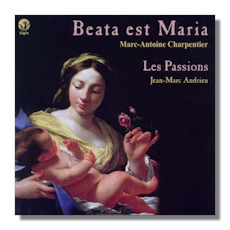
The Internet's Premier Classical Music Source
Related Links
- Charpentier Reviews
- Latest Reviews
- More Reviews
-
By Composer
-
Collections
DVD & Blu-ray
Books
Concert Reviews
Articles/Interviews
Software
Audio
Search Amazon
Recommended Links
Site News
 CD Review
CD Review
Marc-Antoine Charpentier

Beata Est Maria
- Magnificat, H. 73
- Motet "Beata est Maria", H. 25
- Ouverture pour l'église, H. 524
- Motet "Veni creator", H. 54
- Prélude, H. 23a
- Motet "Salve Regina", H. 23
- Motet "Ad Beatam Virginem 'Hodie Satus'", H. 340
- Prélude, H. 237a
- Motet "élévation pour la paix 'O bone Jesu'", H. 237
- Ouverture Pour un reposoir, H. 523
- Motet "Laudate Dominum", H. 159
- Litanies de la Vierge, H. 84
Vincent Liève-Picard, high tenor
Sébastien Obrecht, tenor
Jean-Manuel Candenot, bass-baritone
Les Passions/Jean-Marc Andrieu
Ligia LD202233
The quality of the performances on this excellent CD from Ligia ought to help augment the reputation of Marc-Antoine Charpentier (1643-1704). His is beautiful, extraordinarily-well crafted, imaginative, highly expressive music which occupies a unique place in the music of the French High Baroque.
The nine-person chamber orchestra, Les Passions, is joined by three soloists, Vincent Liève-Picard (countertenor), Sébastien Obrecht (tenor) and Jean-Manuel Candenot (bass-baritone) for a collection of pieces for the male voice in editions by the conductor, Jean-Marc Andrieu, who also founded the period instrument specialist group in 1986; it's resident in Montauban.
At various stages during his time in Paris (from the late 1660's onwards) Charpentier had the famous, and typically French, trois vois égales combination of voices at his disposal… high tenor, tenor, bass. It is for this arrangement of ranges that the music on this CD has been gathered, and is so stylishly performed. The singing is sensitive, though never wavers or is tentative. The singers are completely at home in this repertoire. The instrumentalists strike a fine balance between supporting the words and adding much more than color to our appreciation of the text. Tempi, textures and – in particular – just the right density or clarity convey the intensity and conviction of the liturgical milieu. The opening Magnificat, H. 73 [tr.1], for example, is very Italianate and could almost be taken for an arrangement of Monteverdi at first. On the other hand the Ad Beatam Virginem "Hodie Satus", H. 340 [tr.7] (also rather Italianate), for example, is thoughtful and dour – though without verging on the ponderous or maudlin. It's obvious, for all their immersion in the music, that soloists and ensemble have assessed, internalized and made their own every facet of these pieces – each in their own right.
Furthermore, rather than "work their way through" the dozen discrete works (only the first and last extend to more than nine minutes), each is approached as valid, self-contained and worthy of our full attention. The pace and alternation of vocal and instrumental forces lends the impression of just under one hour's music great variety and freshness. What's more, this sequence shows Charpentier's amazing command of a range of genres, from the narrowly spiritual (Beata est Maria, H. 25 [tr.2] itself) to the more broadly political (élévation pour la paix "O bone Jesu", H. 237 [tr.9], which probably marks a French military victory). Then, within certain works tempi, timbre and pace all vary – Litanies de la Vierge, H. 84, H. 84 [tr.12], for example. This alone must commend Charpentier to those otherwise unfamiliar with his idiom as a major (and so, now, unjustly overlooked) composer.
The acoustic of this recording is clear, penetrating; yet appropriately warm. It adds to our sense of this music's presence and immediacy – a necessary advantage in liturgical music. The Latin (all texts are reproduced in full in the booklet) is enunciated in the French style. Said booklet is informative, despite a rather confusing color-scheme of light plum and white, which doesn't actually carry the layout and content messages which it might seem to be doing. For collectors of Charpentier's music, this is a CD to buy without hesitation: there are few or no creditable recordings of the majority of works so well performed here. An excellent addition to the catalog.
Copyright © 2012, Mark Sealey.





















